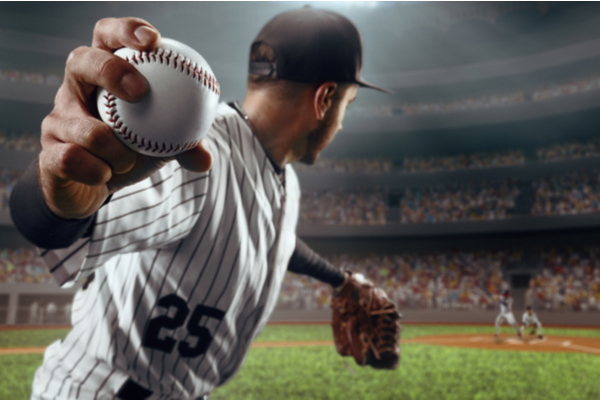Spring is fully underway across the United States, although it might not feel like it in some locations. And to the delight of baseball fans, it’s also the kickoff for the Major League Baseball season. Unfortunately, as AccuWeather reports, this season will be matching up all too well with the peak of severe weather.
In fact, according to Scott Mackaro, the head of innovation at Vaisala, a Finland-based lightning research firm, upwards of 90% of the lightning that happens in the United States, specifically the lower 48, occurs during baseball season. Even more shocking, data from a study published last year shows the chances of getting struck by lightning during a baseball game are surprisingly high.
Chris Vagasky, the author of the study, examined about 9,000 MLB games between 2016 and 2019 and found that lightning occurred at an unsafe distance during more than 700 games. That’s one out of every 14 games.
The National Weather Service (NWS) says that lightning can strike up to 10 miles away from a thunderstorm, but for the purpose of the study, Vagasky used a distance of 8 miles.
Vagasky said that the timeframe of the study started an hour before the first pitch and an hour after the game ended to account for fans entering and leaving the stadium. “What we found is that in about 10% of all games, lightning strikes within that danger area,” Mackaro said to AccuWeather National Reporter Emmy Victor in an interview. “It’s not a one-size-fits-all when we say 10%, some areas get it a lot worse than others.”
Some areas in the U.S. are more prone to lightning than others. Florida historically has been deemed the lightning capital of the U.S., meaning it gets more strikes per square kilometer than any other state in the country.
And sometimes, the most dangerous place at a baseball game isn’t even in the arena, Mackaro explains. “If you think about stadiums, you know, they tend not to be surrounded by a lot; they’re sort of out in the open surrounded by this big parking lot. There’s not a lot of places for lightning to strike,” Mackaro said. “There’s an old adage that it tends to strike a very high place, but if you’re the tallest thing in a parking lot, that becomes a problem.”
As for recorded on-field lightning strikes, there has only been one in the history of the MLB, and it happened over a century ago. On Aug. 24, 1919, at the bottom of the ninth, Cleveland pitcher Ray Caldwell was just one out short of finishing the game against the Philadelphia Athletics when a lightning bolt struck him. “Boom!” reads SABR.org’s historical recount. “A game which had featured little action, and even less drama, suddenly turned into a frightening spectacle.”
For five minutes, Caldwell lay unconscious on his back, as many feared he was dead. As teammates gathered around Caldwell, their legs went numb due to the current entering their bodies through the spikes in their cleats. Miraculously, Caldwell regained consciousness, stepped back onto the mount and, while still in shock, went back to work pitching. He retired the Athletics’ Joe Dugan to complete the 2-to-1 victory.
According to Vagasky’s research, the MLB stadium with the highest number of games played with lightning nearby is LoanDepot Park, which is home to the Miami Marlins. However, this stadium has a retractable roof, which allows games to still be played despite the rain, high heat and humidity common in the Miami climate.
As for open-air stadiums, Coors Field in Denver, home to the Colorado Rockies, has the most lightning activity. Dodger Stadium in Los Angeles, Oakland Coliseum in Oakland, California, and Petco Park in San Deigo were among the only three stadiums found lightning-free.
Of the 30 MLB stadiums, only eight are considered to be StormReady supporters through the NWS StormReady program. This program promotes lightning safety through the preparation, monitoring and execution of emergency plans. As of 2023, the MLB is not required to be a part of this program.
However, these statistics shouldn’t deter people from enjoying a baseball game or any outdoor event. Having a plan in place and knowing where to go if lightning is in the area will keep any eventgoer safe. “We’re lucky enough all to now have these mobile phones in our pockets that are full of technology warning us when there’s severe weather coming,” said Mackaro. “Pay attention to your mobile phone. Pay attention to those warnings. Get yourself to safety.”
Experts advise having multiple ways to receive weather alerts, and knowing where to seek shelter. According to Mackaro, the bathrooms at any MLB stadium tend to be “very large concrete structures,” which is good for protection against lightning. Mackaro says being outside or near large metal structures increases a person’s risk.
“Most stadiums are very good at warning their patrons that something is happening; there’s almost always designated shelters,” Mackaro said. “You need to get you and your loved ones to safety immediately. There’s always a tendency to say, ‘Oh, I want to see the weather.’ It’s just not worth it.”
—
Photo Credit: Alex Kravtsov / Shutterstock.com
